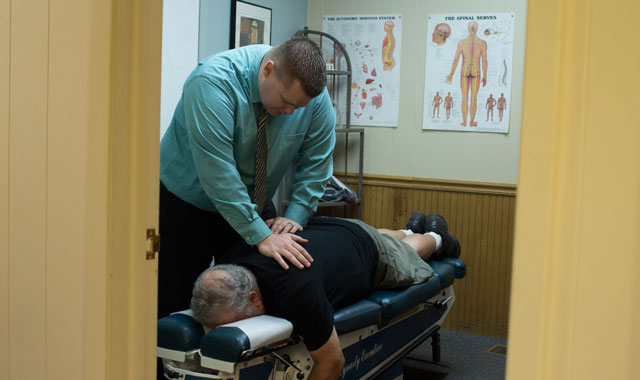Spending hours at a desk can lead to awful aches and pains. Consider these five tips from Strelcheck Chiropractic for maintaining a better posture at your desk.

You’ve heard it said that work can be a pain. But quite literally, work can cause you some serious aches and pains.
Dr. Peter Norton, DC, a chiropractor at Strelcheck Chiropractic Clinic in Crystal Lake and Barrington, treats many people who’ve experienced pain related to work.
“Back in the 1950s and 1960s, when Dr. Daniel Strelcheck Sr. opened Strelcheck Chiropractic Clinic, many of his patients complained of lower back pain caused by heavy construction jobs,” says Norton. “Now, we see a substantial number of patients in our Crystal Lake and Barrington clinics who spend their days, and often nights, sitting in front of computers.”
Though desk work is considerably less strenuous than construction, the discomfort caused by long hours doing computerized work is every bit as painful. With three generations of chiropractors on site, the team at Strelcheck Chiropractic helps patients to prevent muscular and structural aches.
“As chiropractors, it is our job to help patients maintain proper alignment,” says Norton. “At Strelcheck Clinic, we want that commitment to include prevention as well as treatment.”
Prevention begins with a few simple techniques.
“The No. 1 reason why patients experience this is poor posture,” Norton says. “Awkward positions and long periods without relief have a biomechanical effect on their muscles, skeletons and circulatory systems. They tend to hunch over, heads forward and spine bowed. This puts pressure on the lower back and pelvis.”
Here are five ways to maintain a better posture at your desk.
1. Monitor Your Monitor
The computer monitor should be placed at eye level, in a location where you’re not constantly looking up or down.
“I have patients who work with two or more monitors, so this can be a challenge,” says Norton. “Over time, this strains the neck and upper back muscles, and it leads to stiffness plus pain.”
2. Don’t Reach For Your Keyboard
The computer keyboard ought to be placed comfortably within reach.
“The user should be able to sit at the computer, arms down at their sides and elbows bent at a 90-degree angle,” says Norton. “When they have to reach out or up to work the keyboard, it places strain on the back, shoulders, elbows and wrists, which can lead to several uncomfortable conditions including carpal tunnel syndrome in the wrists.”
3. Mind Your Posture
Proper posture is essential to avoiding pain. Your back should remain straight and aligned with your hips and legs.
“Don’t lean forward, backward or to one side,” says Norton. “Feet should be flat on the floor. Don’t cross your ankles or legs. Avoid slumping and reaching too far, which creates an inflex that locks the muscles into a tight position, causing pain.”
4. Stand Up and Stretch Out
It can be easy to lose yourself in work and remain glued to your chair all day. No matter how small your workspace, find reasons to get up and move around.
“Some work spaces are closely designed, but someone can still stand up and walk in place or stroll down the aisle,” says Norton. “They can stretch and do a series of squats to loosen and flex muscles. Waiting until the end of the work day and exercising does not counteract the effects of working in a cramped position for hours.”
5. Improve Your Seating
Ergonomically designed desk chairs can help to improve posture, but Norton also suggests using an exercise ball as an alternative to a desk chair.
“The balls force you to sit upright and have the added advantage of moving around,” says Norton. “Also, if the chair is too deep, lumbar pillows are a good option. And the new stand-up computer desks are beneficial as well.”





















































